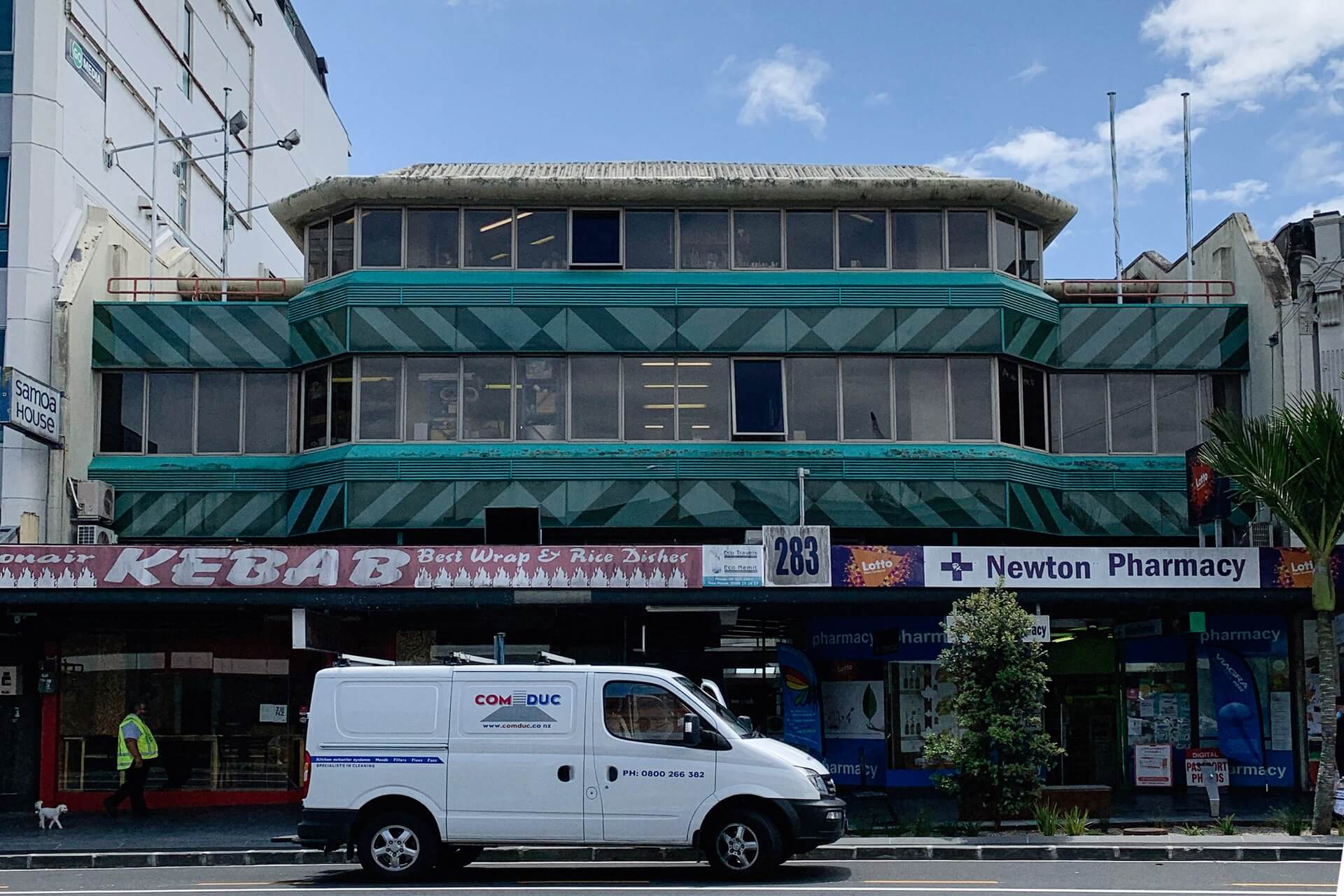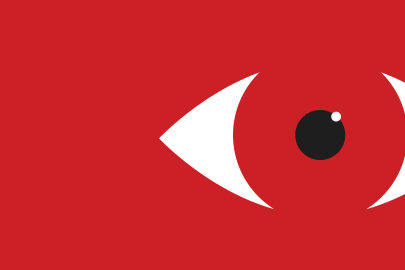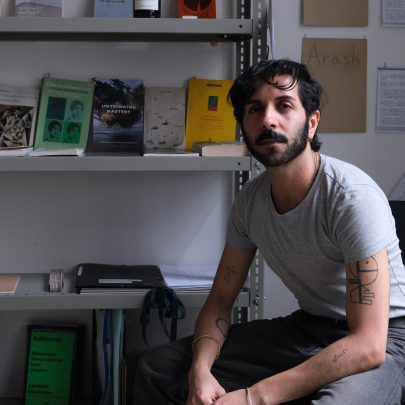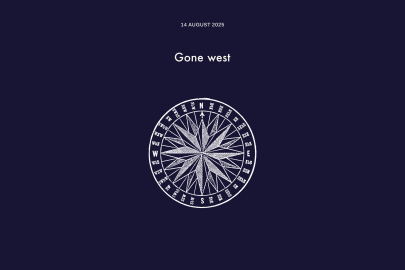Feb 23, 2022 Art
It’s a pretty shit time to be an artist.
There is of course brilliant art being made, exciting opportunities open and a heap of forthcoming work that I am dying to see. But writing from day 79 of Auckland’s lock down, borders still closed, combined with a never ending housing crisis which sees both the cost of housing and living rise to untenable rates, it’s becoming increasingly clear we are living through conditions which are not conducive to the creation of good art.
Those needs are not some long unattainable list by the way. In essence they are: the ability to live, to be surrounded by different ways of thinking, and to be able to make. At the risk of a “back in my day” flash back (which to be fair was not that far back), when I went through art school, I temporarily flatted in Grafton and lived on a total weekly income of $120. My rent was $55 per week, albeit a room shared with a mate. On that weekly income though, I made art, ate well, managed to still party in the weekend, and I owned a car which I could afford to put petrol into.
Living on $120 per week today is unfathomable. Numbeo, a cost of living database, estimates that the cost of living in Auckland is $1484 per month for a single person without rent, and $5391.00 for a family of four per month also without rent. In 2019, the estimated average income for designers and artists was around $55,100. Although the data from the Ministry of Business Innovation and Employment shows that it is significantly higher for some kinds of designers, while being significantly lower for artists. This is in stark contrast to the average national annual household income which in 2020 increased from $103,991 to $107,196.
And so in today’s economic conditions, where an artist cannot afford to live and make work in ways that they used to, the need to earn a living means that, as Sarah Schulman notes in her book The Gentrification of the Mind, the artist’s goals are altered by necessity. Given the impossibility of life, the way in which the housing market is driving intense change and gentrification on its own across all of Auckland, does the artist today still play the same role in gentrifying the city?
In a previous issue of Metro, Donna Chisholm charted the way in which the first Covid lockdown exacerbated the city’s inequities stretching the wealth gap. That article quotes Max Rashbrooke as saying, “You see concentrated neighbourhoods of wealth and concentrated neighbourhoods of poverty and people don’t mix as much as they used to.” These concentrations have key impacts in societies ability to empathize and understand experiences beyond one’s own, within a contemporary art context diversity of thought is imperative. According to Schulman, “the daily affirmation that people from other experiences are real makes innovative solutions and experiments possible. In this way, cities historically have provided acceptance, opportunity, and a place to create ideas contributing to freedom.”
A place like Karangahape Rd has always been an artists’ haven for this very reason. I went to high school off K Rd and was often amongst the first lot of girls to school. I missed the rush of the “blue sea” as us Auckland Girls’ Grammar School kids were called en masse. That meant that I often just missed the remnants of the night. Avoiding vomit sticking to my Rugged Shark school shoes and dodging any discarded condoms was like a game. That same street would later be somewhere I would go to club underage on a borrowed ID, and then home to another kind of community I would come to belong to – Auckland’s art scene.
Since I was 13, that street has gone through immense change. A Tesla car yard where the cars are inside the shiny rooms, which was once at odds with its surrounding, has come to be well at home with the latest ‘enhancements’. Mercury Plaza’s Chinese Cuisine, where my partner and I had our first date, was pushed out and replaced with a train station. Even though the change is immense, sometimes it takes seeing what you take for granted through someone else’s eyes for you to see it for yourself. In Isobar Precinct by Angelique Kasmara, a somewhat spooky novel which opens in Symonds St cemetery and circles between a tattoo shop on K Rd, a sex workers collective, and the City Mission. All places which despite the novel being fictional are achingly familiar. The characters similarly feel like those you may imagine (if not know) to make up the chorus of K Rd and it’s different class experiences you too found on any given day.
Gentrification of K Rd started long before my third form year at high school though. Arguably, you could trace it all the way back to colonial settlement of central Auckland. More recently though, there is a well charted history of Pacific migration to central Auckland from the 1940s onwards, with archival footage of K Rd filled with Pacific people going about their business – the Newton Pacific Island Church (founded in 1947) and Samoa House (then the Samoan Consulate, opened in 1979) are relics of that time. From the late 70s and early 80s, Pacific people were pushed South and West and K Rd became a main shopping street, with Las Vegas Strip Club (which opened in 1962) above a T&T Children’s Wear shop.
In the late 80s with the development of Auckland’s motorways and with the 1986 homosexual law reform, residential housing was largely gone and K Rd become the home to Auckland’s queer community, sex working community, homeless communities, and arts communities as we know it today. By 1987, Artspace New Zealand had their K Rd gallery open, and the rest is history.
Emil Scheffmann was one of four artists who co-ran a space called Fuzzyvibes from 2013 to 2015 in the basement of 151 K Rd (now a backpackers hostel). Having recently returned from London he draws parallels between K Rd and Black, Asian and minority ethnic neighbourhoods in the UK, where “largely white – albeit poor – creative communities move in, enabling the interest of the property class, followed by large corporate bodies. It is slow violence – one initiated by well-meaning and often socially engaged white people.”
The artist studio – something affordable where artists of different perspectives can come together and make work outside of the limitations of the 9 to 5 model – is traditionally part of the necessity of being an artist, and K Rd is lauded as an ideal location. Space to experiment, ponder, exhibit and party in all of the romantic artist trope glory. I recently asked on Instagram if any of my followers (a pretty good cross section of the Auckland art scene) actually had and could afford a studio full stop let alone one on K Rd, about two artists had one (one for not too much longer they assured me), while others made use of garages, bedrooms and dining room tables. The artist-studio reality is now out of reach for many.
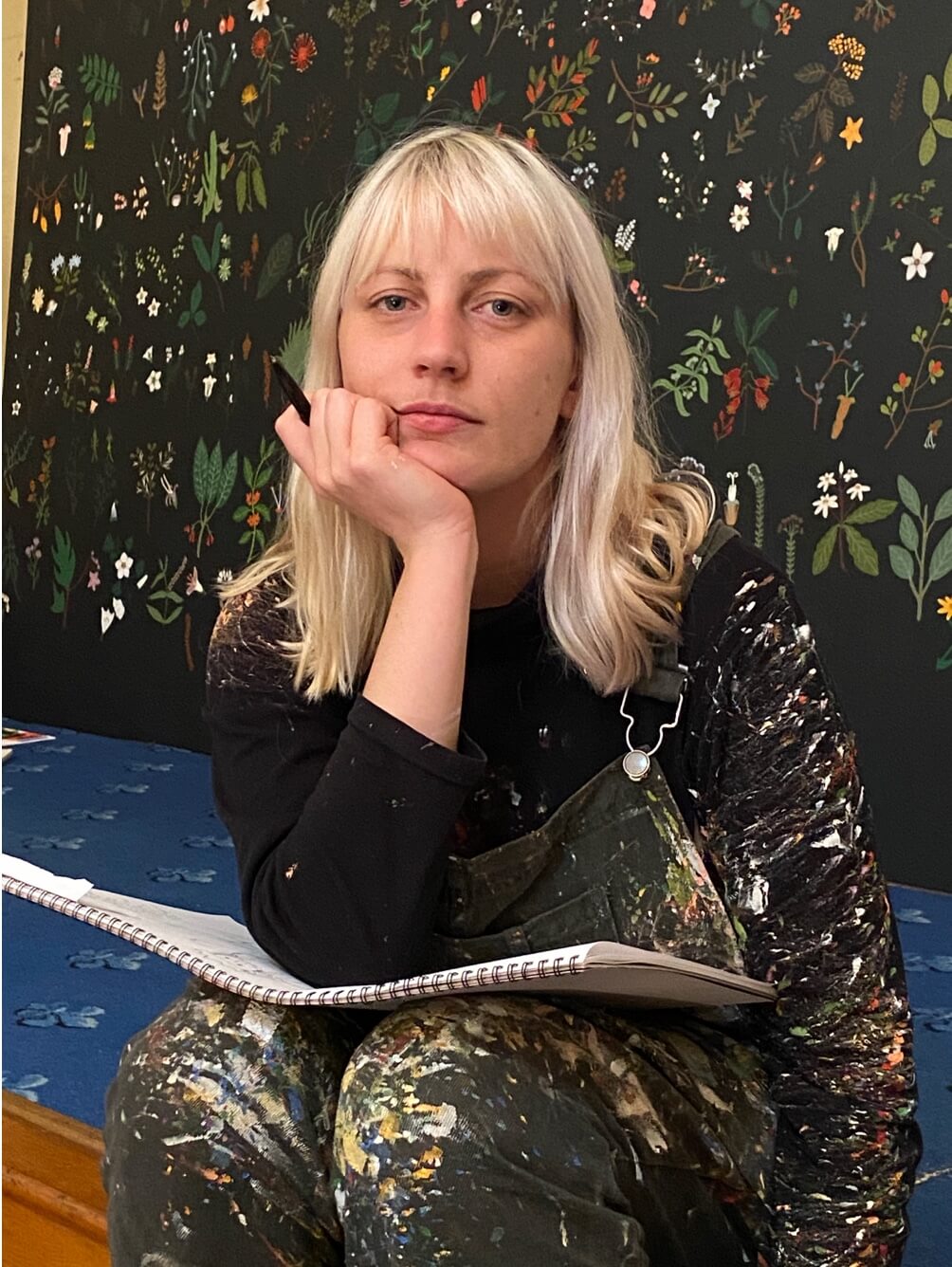
Ayesha Green photographed by Jameela George
Ayesha Green is one artist who has had a studio on K Rd for three years, until very recently. “The future of K Rd art making is reserved for the wealthy or the exhausted,” she tells me on the day after having moved out her K Rd studio due to affordability and instability. For Green, a painter, rent has become so unaffordable that artists have to sacrifice their standards of living in order to keep up with rising rents. This means that “artists can’t afford to make artwork that fails. An arts practice is that, to keep practicing, trying, developing, failing, there is no room to practice, it’s too expensive to practice.”
Green tells me, “Auckland is creating a generation of artists who are exhausted from working full time and are still poor because they are having to spend all of their money on rent. It’s really difficult to be thinking creatively when you’re exhausted from the constant strain and stress of trying to make ends meet while also maintaining an arts practice and be a part of an arts community and the care and energy that that takes.”
“Every time an old business closes down (which is often) I wonder and worry what will take its place,” Sam Walsh of Strange Haven/Strange Goods, a combined workspace and bookstore, tells me. Strange Haven/Strange Goods have been on the strip for over four years, nestled next to Uncle Mans.“We’ve had our rent increased, our operating expenses hiked and have had to rejig our business model a few times now just to curb the impacts of gentrification.” Walsh is inundated with requests to rent their studios, many from artists who have been kicked out or had to leave or organisations and galleries that have closed down due to increased rents. Unfortunately Strange Haven/Strange Goods is a small space meaning that they can’t cater to the full needs of many artists. How long Walsh and co will be able to hold on to they’re K Rd spot is unknown. “We’re a quarter of the way through our final two year term and once that ends I’m expecting our rent will be raised to a point that no longer makes our business viable. In three years our cute little store and studio will probably be turned into a slick Tapas Bar or a Vodafone store or Yoga Studio but maybe things will swing the other way. Here’s hoping.”
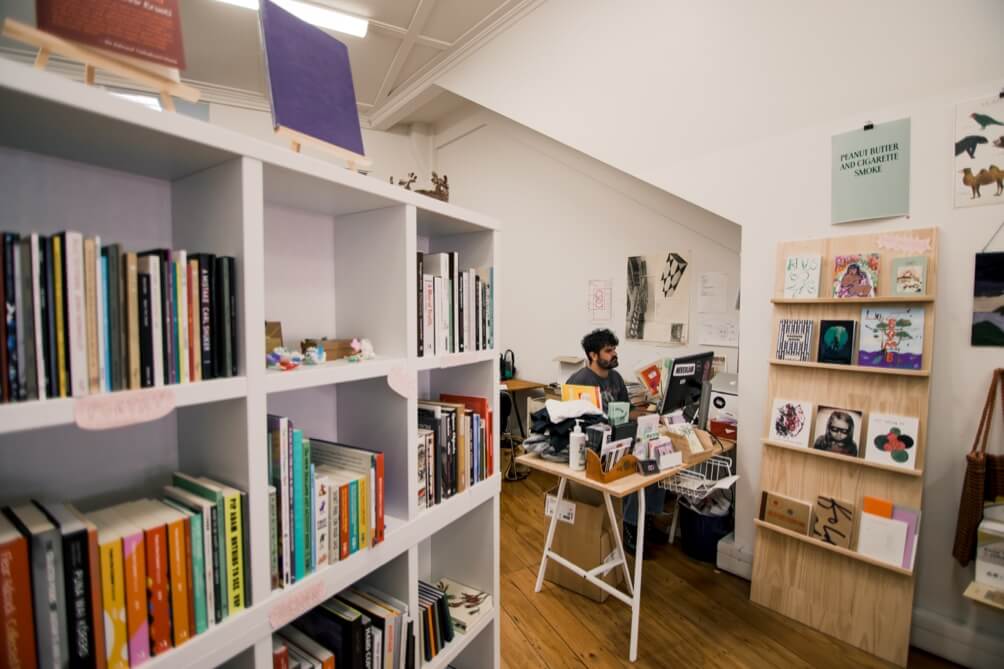
Sam Walsh at Strange Goods photograhped by Julie Zhu
The tradition of the artist run space and the artist studio, seems very impossible to the future generations of art school students. Ophelia King who was also involved in Fuzzyvibes shared that during a recent talk with fine art students they “felt forced to give up on the possibility something could come to fruition as soon as they began searching for space,” she says. “To have such impossible hurdles before the process has even begun is disheartening to say the least. This naturally also goes for artists trying to find studio spaces. The crazy thing is there are spaces that are empty on K Rd and throughout the CBD but they aren’t affordable and it’s more lucrative for the owner to leave it empty than to lease it for less.”
One lifeline for a group of artists has been Samoa House, which became available after an opposition Samoan MP raised concerns about the high cost of lease for the K Rd Samoan Consul General’s office in Auckland, leading to the government to purchase four acres of land in South Auckland in 2008, eventually opening their new building Fale O Samoa in 2016. Samoa House on Krd a multifloor building, with its Samoa House Banquet Hall designed by JASMAX Architects who adapted the traditional fale afolau, was leased out by the consulate and was taken up by a variety of artists and arts organisations.
One group which has taken residence in Samoa House, is Samoa House Library named in honour of their new home on the second level of the building. The independent library formed in response to the closures of the specialist libraries namely the Fine Arts library at The University of Auckland. In addition to being a library the group holds education programmes, a research-based residency programme and hosts ten studio spaces.
I visit Samoa House for the first time in many years to have a meeting at Silo Theatre, which has taken up residence in one of the spaces on the street level. While many seem to be moving out or bracing themselves to be moved on very soon, Silo Theatre are somewhat the new kids on the block. Drawn to the strip for the same reason many artists and creative organisations are for the incredibly alive and energised nature of the strip with its amazing cross over of all walks of life. Interestingly Silo Executive Director Jess Smith tells me that their move from Mt Eden to Samoa House was partly because it was more affordable, and on a personal note was also a homecoming for the AGGS girl. Smith compares it to the Britomart precinct which was once inhabited by a lot of art studios and arts organisations. But rather than seeing it as a place doomed to a similar fate, Smith offers a hopeful vision, calling to major players such as the council to protect K Rd and ring fence it as part of an important part of the city, so that all the walks of life that call it home can’t be moved along.
On that visit to Samoa House, unexpectedly I feel a wave of nostalgia and sadness, knowing what it means to see artists and arts organisations take up residency in a space which is also a cultural home for an urban Pacific. I see the ghosts of those waiting in line to get their passports stamped and visas approved. The banquet hall, often described as the first fale to be created and built outside of Samoa, brings back memories of 18th and 21st birthday parties, it also ushers in a particular kind of PTSD that comes with having to put on family items as a youth, getting ready in the bathrooms below the fale itself, and standing on the stairs in our uniforms waiting to make our grand entrance, ‘ata mai’ an aunty yells.
I celebrate the ways that artists are finding solace, but I am haunted by the disappearance of the memories of this place. There is a weird tension when one community – artists that are dealing with the destruction of their places like libraries and institutions, have taken over sacred cultural sites for an urban pacific, another community who sites are similar under threat. It becomes a strange kind of cannibalistic race to see who can hold on the longest to remain in the city, which is soon to purge everyone.
Under gentrification, Schulman tells us, “to imagine one’s self as an artist, negotiate the expense of art-making, and—most challenging of all—to be allowed, by the tight fist of the prevailing institutions” is “to emerge without losing one’s soul”. The loss of one’s soul in this instance is a question of conforming to aesthetics and values, which results in a homogeneity of difference. It “enforces itself through the repression of diverse expression”. We know that artists are active agents in gentrification. With the costs of living so high at the moment in Auckland it might be easy to think that artists don’t have such an active role in processes of gentrification, however I am not too sure.
Damon Salesa wrote about the racial segregation of Auckland in 2018 commenting that “Racial segregation is ordinary in Auckland but it is extraordinary to talk about it.” We need to talk about the way in which ethnic and class concentrations are deep and powerful, and if they continue without acknowledgement impact “our public and civic conversations”, namely Salesa notes, “the experience of Pacific peoples in a city where they are the most segregated population demands a level of scrutiny and analysis we have yet to give.”
I wonder if holding onto K Rd as an artistic centre, is an example of what Schulman describes as gentrified happiness, which she describes as “available to us in return for collusion with injustice. We go along with it, usually, because of the privilege of dominance, which is the privilege not to notice how our way of living affects less powerful people”. To hold on to centre as artists is to close our eyes to the dislocation of our non-white, queer, sex-working, homeless communities. It’s the privilege of us as creative folk “not to notice how our way of living affects less powerful people.” Schulman continues, “Sometimes we do know that certain happiness exists at the expense of other human beings, but because we’re not as smart as we think we are, we decide that this is the only way we can survive. Stupidity or cruelty become the choice, but it doesn’t always have to be that way. After all, people and institutions act on and transform each other.”
“The divide between people who can afford to make work, and the people who can’t is growing” Ayesha Green continues. “Art making is currently predominantly reserved for people who have access to wealth, or have safety nets, this divide is growing even wider. What we will be left with is a practicing upper middle class. If our art is meant to tell the story of New Zealand, then we are going to be left with a very one sided story. This also means that the art market, the wealthy, will continue to grow in power and dictate what art gets made and by whom.”
As Ophelia King points out, this disparity impacts significantly on the sense of community. King comments, “I think the critical exchange would be drastically lessened – and is probably creating a lot of somewhat lonely practices and outputs. I believe that critical discourse around art and art-making is developed over time and needs maintenance – or it becomes scary and feels overwhelming again, I wonder where those conversations now happen – perhaps it’s via DM but sadly I imagine its mostly not at all”.
I used to feel at home in the centre of the city. But more and more it feels like a toxic wasteland of high end development and artists not thinking they’re a part of what’s happening. What does it mean when we commission our artists to beautify a fence hiding a development, are they not helping to beautify the process of transformation that will soon see them too pushed out? Is that not gentrification art?
The cost of living has made it incredibly difficult to be an artist, many of us live on the cities fringes (and always have). Many of us are also now reliant on full time jobs, or public funding, or both. While there are many processes at work, artists can’t be too quick to obfuscate ourselves from our responsibility.
Scheffmann shares an anecdote admitting that when they started Fuzzyvibes there was a mural “involving a pinched bottom and a lot of 70s swirls at street level. I don’t know if anyone on the street really loved it, but it was irrefutably iconic of K Road.” While the collective was aware of the “interplay between art and gentrification and debated for a long time how to create an identity that would not cohere to the logic of that cycle” they decided to paint the mural grey and put up a minimal lightbox in Helvetica. With retrospect Scheffmann admits, “I wish we’d had the guts to recognise something of meaning in that context and preserve it, or at least more sensitively re-contextualise it.”
I wonder too if Samoa House’s fale, and the rainbow crossing will become mere tributes to communities whose presence is soon to be fully erased and painted over. The Tesla’s are here, and soon we may all be gone.

